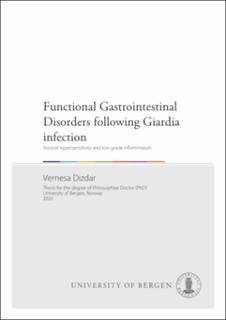| dc.description.abstract | Background:
Giardia lamblia is a non-invasive protozoan parasite, infecting mainly the upper small intestine. It is the most common cause of waterborne outbreaks of diarrhea in an endemic country.
The first registered large outbreak of giardiasis in Bergen occurred Autumn 2004, where about 1262 subjects were diagnosed with Giardia lamblia and 139 continued to have abdominal symptoms, despite several treatments with metronidazole. A long-term follow-up study from our group showed that a subgroup of these patients developed symptoms consistent with Giardia induced Post-Infectious Functional Gastrointestinal Disorder (PI-FGID).
Aims:
This thesis aimed to study visceral sensitivity and low-grade inflammation, assessed by duodenal EC cells, serotonin (5-HT), cholecystokinin (CCK), T- and B-lymphocytes in patients with long-term abdominal symptoms after Giardia infection. The most of PI-FGID patients had an overlap of FD and IBS.
Methods:
In Paper I, gastric emptying and visceral sensitivity were assessed in PI-FD/IBS patients and recovered controls (RC) by using 3D ultrasonography (3D US) in combination with a low caloric soup meal. A subgroup of PI-FD/IBS patients underwent a double-blind, randomized, placebo-controlled study with 5-HT3 antagonist (Ondansetron®) in combination with a low-caloric soup meal and 3D US.
In Paper II, fasting and postprandial changes in plasma 5-HT and CCK after the carbohydrate-rich meal were assessed in PI-FD/IBS patients and RC. In addition, duodenal EC cells, 5-HT, CCK, mast cells and CgA were stained immunohistochemically (IHC) and quantified.
In paper III, duodenal mucosal intraepithelial lymphocytes (IELs), lamina propria villus (Lpv) and lamina propria crypt (Lpc) for CD3+, CD4+, CD8+ and CD20+ lymphocytes were stained immunohistochemically (IHC) and quantified in chronic giardiasis (CG) patients, PI-FGID patients, recovered controls (RC) and healthy (non-Giardia exposed) controls (HC).
Results:
In Paper I, PI-IBS/FD patients had more abdominal symptoms as well as lower drinking capacity and increased visceral sensitivity. 5-HT3 antagonist (Ondansetron®) had effect on postprandial nausea, otherwise there was no effect on other symptoms, drinking capacity or gastric emptying.
In Paper II, only a few PI-FD/IBS patients had a sign of microscopical duodenal inflammation. When compared to recovered controls, patients had lower duodenal 5-HIAA/5-HT ratio and reduced duodenal 5-HT containing EC cell counts. There was a positive correlation between duodenal EC cell numbers and mucosal 5-HT content in the PI-FD/IBS patients, who also had increased number of duodenal CCK containing cells with a greater CCK/5-HT ratio compared to recovered controls.
After the carbohydrate-rich meal, PI-FD/IBS patients had lower fasting and postprandial plasma 5-HIAA, with a higher abdominal symptom score compared to RC. Plasma 5-HIAA showed no correlation to abdominal symptoms. CCK plasma levels did not differ between PI-IBS/FD and recovered group but showed positive correlation to fullness and bloating in PI-IBS/FD patients.
In Paper III, duodenal IEL CD4 cells was significantly elevated in chronic giardiasis and then decreased, followed by an upwards trend after one year in both the PI-FGID and recovered control group. Duodenal lamina propria crypt CD4 T cells were lower in chronic giardiasis patients and remained low for about 14 months before normalizing. Duodenal lamina propria crypt (Lpc) CD20+ cells were persistently elevated, longer than 19 months, in all three Giardia exposed groups, compared to healthy controls.
Conclusions:
Patients with persistent abdominal symptoms after cured Giardia infection, in whom most had overlap IBS and FD, had increased visceral sensitivity with lower drinking capacity and delayed gastric emptying assessed by the low-caloric soup test combined with 3D ultrasound.
The 5-HT3 antagonist (Ondansetron®) improved only nausea without influencing other symptoms, drinking capacity or gastric emptying (Paper I).
These patients had decreased number of 5-HT containing EC cells and increased number of duodenal CCK containing cells, with a greater CCK/5-HT ratio compared to recovered controls (Paper II). After intake of the carbohydrate-rich meal, PI-FGID patients had lower plasma 5-HT, before and after a meal, with more dyspepsia symptoms, without significant differences in plasma CCK.
The decreased number of duodenal CD4 cells in the lamina propria crypt, were found in chronic giardiasis and PI-FGID patients, but also recovered controls, and it normalized approximately 14 months after the acute illness, while elevated B cells in the crypts appeared to last longer than 19 months in all three Giardia exposed groups (Paper III).
In PI-FGID group, duodenal EC cell counts (Paper II) were positively correlated to persisting low duodenal Lpv CD4 and Lpc CD4 cells (Paper III) | eng |
| dc.relation.haspart | Paper II: Dizdar V, Spiller R, Singh G, Hanevik K, Gilja O.H, El-Salhy M, Hausken T.
“Relative importance of abnormalities of CCK and 5-HT (serotonin) in Giardiainduced
post-infectious irritable bowel syndrome and functional dyspepsia” Aliment
Pharmacol Ther (2010) 31, 883–891. The article is available in the main thesis. The article is also available at: <a href="https://doi.org/10.1111/j.1365-2036.2010.04251.x" target="blank"> https://doi.org/10.1111/j.1365-2036.2010.04251.x</a> | eng |
| dc.relation.haspart | Paper III: Dizdar V, Hausken T, Lærum OD, Gilja OH, Langeland N, Hanevik K “Prolonged
duodenal mucosal lymphocyte alterations in patients with and without post-infectious
functional gastrointestinal disorders after Giardia infection”, Journal of Infectious
Diseases J Infect Dis. 2019 Jun 19;220(2):321-329. The article is available in the main thesis. The article is also available at: <a href="https://doi.org/10.1093/infdis/jiy690" target="blank"> https://doi.org/10.1093/infdis/jiy690</a> | eng |

